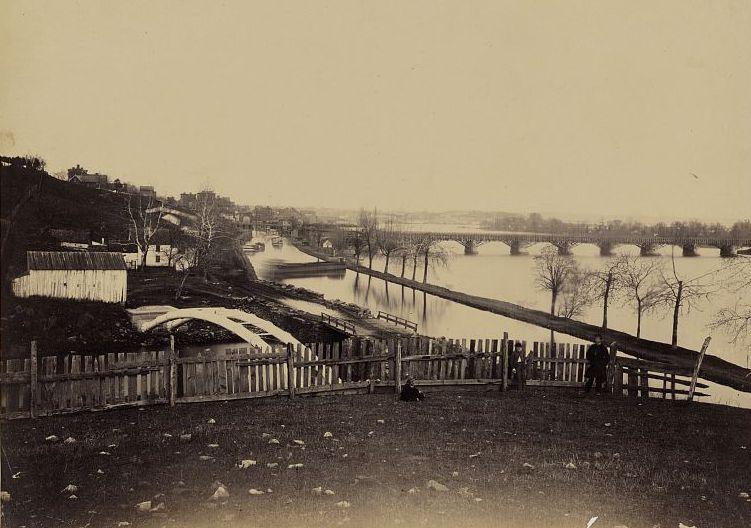
The Aqueduct Bridge, termed in the 19th century "a stupendous work," was considered one of the most remarkable engineering achievements of the time.
In 1830, Congress granted a charter to the Alexandria Canal Co., and negotiations were started with the Chesapeake & Ohio Canal Co. It was soon determined that the two canals would have to be joined across the Potomac, by an aqueduct bridge. Such a construction would allow the canal boats to cross the river without unloading their cargo into sailing ships, a break of bulk which would have made the extension of the shipments to Alexandria prohibitively expensive in comparison with delivery at Georgetown.
The aqueduct was begun from the Virginia side of the Potomac in 1833, the same year that the 7-mile branch canal to Alexandria was begun, and both were completed 10 years later in 1843. The Aqueduct Bridge, termed in the 19th century "a stupendous work," was considered one of the most remarkable engineering achievements of the time. It was almost a quarter of a mile long, and its piers were founded on solid rock, below 35 feet of water and mud in certain places. Reports of it were published both in America and abroad.
The completed bridge was opened on July 4, 1843, 10 years after work began on the Virginia side. The local enthusiasm for this engineering feat can be glimpsed in contemporary guidebooks. William Morrison's guide, published in 1842 before the bridge was complete, includes an engraving of the completed bridge, making it look like its framework sides were covered with sheathing. Since this was the practice with truss work-covered bridges, the artist must have thought that a sheathing would ultimately be added. Major Turnbull had taken the precaution of having all the wood soaked in a recently perfected preservative so that the protective covering needed over covered bridges could be dispensed with here. Bohn's Handbook of Washington, written in 1861, described the bridge as "stupendous" and noted that it has "attracted the attention of European as well as American architects and men of science."
Over the years, the superstructure changed several times. The traffic across the Potomac had grown so much that by 1856, the narrow carriage lane across the Aqueduct Bridge needed to be improved. Several suggestions were made for altering the Aqueduct Bridge, but these were cut short by the Civil War. In 1861, the aqueduct was drained. The bed was used as an ordinary bridge with a wooden approach crossing the Georgetown Canal, connecting 36th Street with the abutment. After the war, in 1866, the bridge was returned to the Alexandria Canal Co., which leased it to the Alexandria Railroad & Bridge Co.
In 1868, Congress authorized the two companies to erect a highway bridge over the trough and charge tolls. The original Queen-post truss bridge was removed, and a new wooden superstructure of Howe trusses, strengthened at the sides with laminated wooden arches, was added. The new bridge had two levels, the lower chord of the truss supporting the canal trough and towpath and the upper supporting the toll road. Because of local objections to the high tolls, Congress authorized the purchase of the bridge in 1881. The Alexandria Canal Co. refused to sell it, so the bridge was condemned and closed to foot traffic. Finally, in December 1886, the Alexandria Canal Co. accepted the purchase price of $125,000.
The superstructure was again changed when a light iron truss bridge was put on the existing stone piers in 1888. Numerous repairs were subsequently made to the piers. In 1903-05, Pier No. 5 was completely replaced. In 1908, new girders were added. The need for a more substantial bridge led to congressional authorization in 1916 for a replacement. In 1920 the present Key Bridge was begun. It was first opened to the public on January 17, 1924.
Images



the canal and Aqueduct Bridge about 1865.